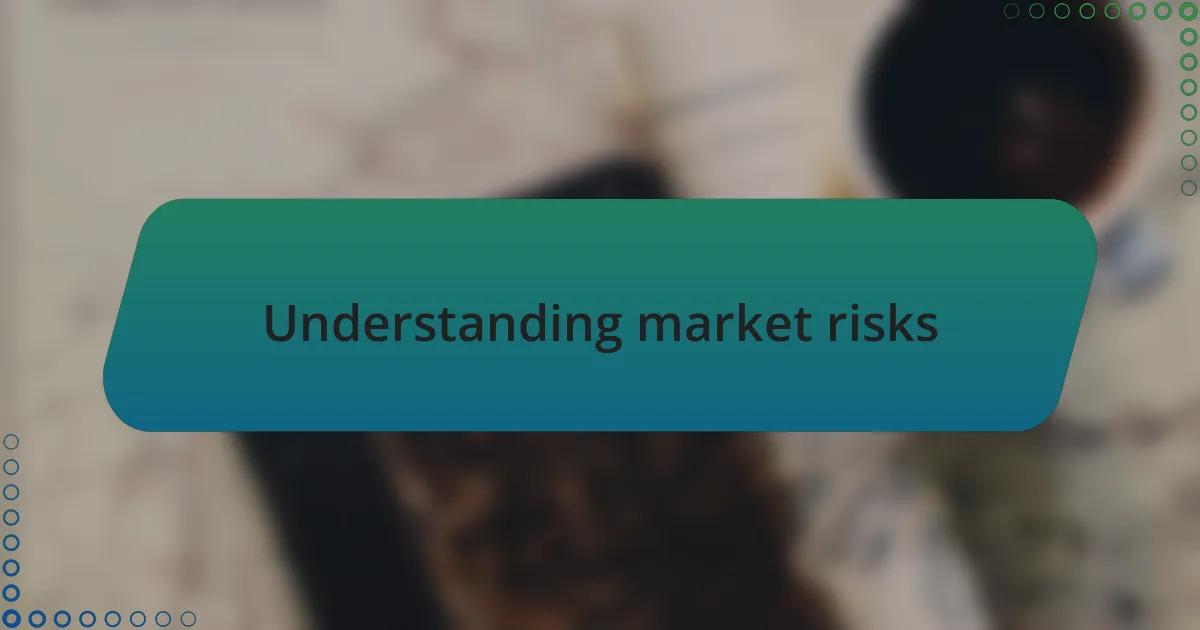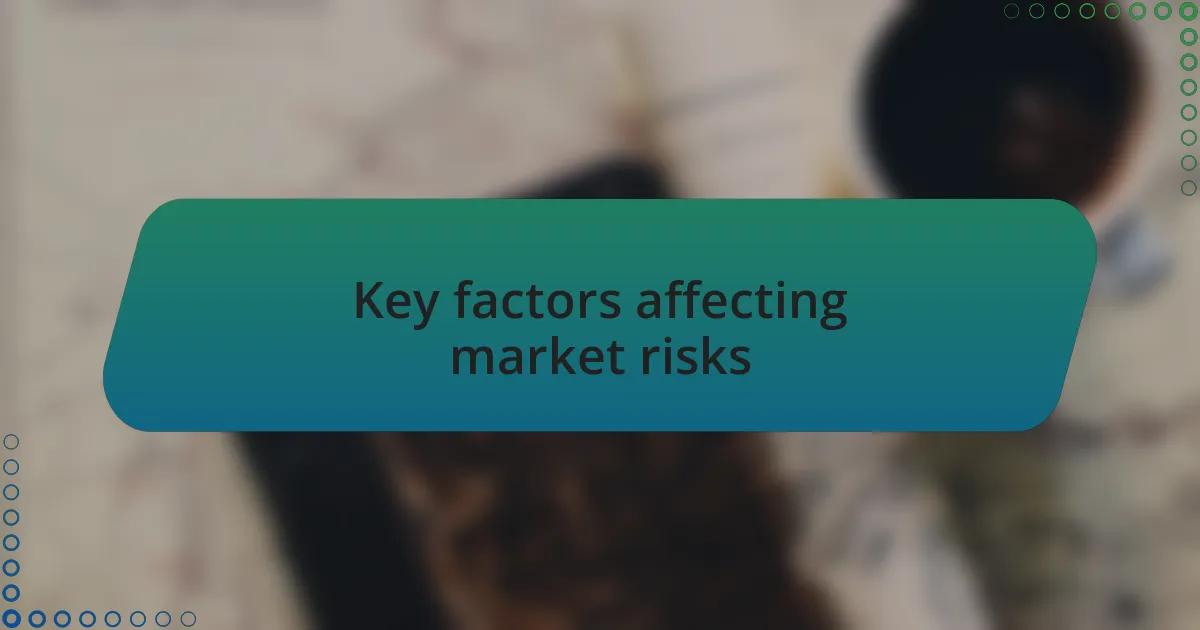Key takeaways:
- Understanding market risks involves recognizing sources such as economic downturns, geopolitical events, and consumer behavior shifts.
- Market risk evaluation empowers informed decision-making and builds confidence in managing investment strategies during uncertain times.
- Key factors affecting market risks include economic indicators, geopolitical events, and market sentiment, which can significantly influence investment outcomes.
- Tools like Value at Risk (VaR), scenario analysis, and market sentiment indicators help investors assess and manage potential risks effectively.

Understanding market risks
Market risks are the potential losses that can arise from unpredictable changes in market conditions, and understanding them is crucial for informed decision-making. I remember when I first ventured into investing; the volatility of the market was overwhelming. I often found myself asking, “What if the market crashes tomorrow?” It turned out that acknowledging my fears helped me better assess my risk tolerance.
As I gained experience, I realized that market risks come from various sources, such as economic downturns, geopolitical events, or even shifts in consumer behavior. Each of these can lead to significant fluctuations in asset values. This understanding pushed me to diversify my portfolio; I learned that spreading investments across different asset classes can serve as a buffer against sudden market movements.
It’s essential to keep an eye on market indicators and economic trends, as they provide valuable insights into potential risks. For instance, when I noticed inflation rates climbing, I started to rethink my investment strategy. This proactive approach allowed me to remain ahead of the curve and mitigate potential losses, reinforcing the idea that being attuned to market dynamics is not just beneficial—it’s essential.

Importance of market risk evaluation
Recognizing the significance of market risk evaluation cannot be overstated. I vividly remember a time when a sudden economic shift caught me off guard; my investments dipped overnight, leaving me questioning my strategies. I realized then that evaluating risks isn’t just about avoiding losses—it’s about empowering myself to make informed decisions during uncertain times.
When I consider my investment journey, I often reflect on how understanding market risks has helped me navigate the highs and lows. I once felt overwhelmed by market news, fearing the repercussions of external factors. However, as I honed my evaluation skills, I found that staying informed transformed anxiety into confidence, allowing me to see opportunities where others saw threats.
Ultimately, market risk evaluation serves as a foundation for strategic investing. It’s like having a compass in a storm; without it, I would have felt lost. Have you ever found yourself adrift in unpredictable market conditions? I know I have, and it’s precisely why I have come to view risk evaluation as an essential practice for anyone serious about their investment journey.

Key factors affecting market risks
Understanding the key factors affecting market risks is crucial for any investor. One significant factor is economic indicators; they serve as vital signals of the market’s health. I recall tracking interest rates and inflation statistics during a period of uncertainty. The data revealed trends that allowed me to anticipate potential shifts, which ultimately influenced my investment choices.
Another factor influencing market risks is geopolitical events. I remember vividly when an unexpected election outcome sent shockwaves through the stock market. It taught me that external circumstances, such as political instability and trade relations, can alter market dynamics almost overnight. Have you ever found yourself reacting to news headlines, only to realize you could have prepared better by reading beyond the surface? Recognizing these influences can help buffer against unforeseen volatility in your portfolio.
Lastly, market sentiment plays a significant role in risk assessment. I used to underestimate how collective emotions could impact stock prices. During one particular downturn, I noticed how fear gripped the market, leading to panic selling. If I had let those emotions dictate my decisions, the consequences would have been far worse. Instead, I focused on analyzing the underlying fundamentals, reminding myself that markets often overreact. How do you usually gauge the mood around your investments? I’ve learned that keeping a level head is invaluable when assessing potential risks.

Tools for assessing market risks
Assessing market risks effectively often involves using a variety of tools. For instance, I frequently rely on statistical models like Value at Risk (VaR), which estimates the potential loss in value of a portfolio under normal market conditions. I remember when I first applied VaR during a particularly volatile market period—it helped me quantify my risk, providing a clearer picture of what to expect and allowing me to plan accordingly.
Another tool that has proven invaluable is scenario analysis. By imagining different market conditions and their potential impact on my investments, I can prepare for best and worst-case situations. I once created a scenario around a hypothetical economic downturn; it not only highlighted my portfolio’s vulnerabilities but also spurred me to make strategic changes that ultimately shielded my investments from significant losses. Have you ever considered how proactive planning can set you apart from other investors?
Additionally, market sentiment indicators, like the Fear and Greed Index, have opened my eyes to the psychological components of investing. I vividly recall a time when everyone was overly optimistic, which led me to question whether my investments were truly sound or if I was simply following the crowd. This experience reinforced my belief that understanding how sentiments fluctuate is essential for making informed decisions. How often do you check what influences others’ perceptions in the market? Embracing these tools not only enhances my understanding but also strengthens my confidence in navigating risk.